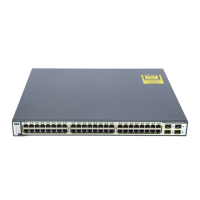32-38
Catalyst 3750 Switch Software Configuration Guide
78-16180-02
Chapter 32 Configuring QoS
Configuring Standard QoS
To return a port to its non-trusted state, use the no mls qos trust interface configuration command. To
return to the default DSCP-to-DSCP-mutation map values, use the no mls qos map dscp-mutation
dscp-mutation-name global configuration command.
This example shows how to configure a port to the DSCP-trusted state and to modify the
DSCP-to-DSCP-mutation map (named gi1/0/2-mutation) so that incoming DSCP values 10 to 13 are
mapped to DSCP 30:
Switch(config)# mls qos map dscp-mutation gi1/0/2-mutation 10 11 12 13 to 30
Switch(config)# interface gigabitethernet1/0/2
Switch(config-if)# mls qos trust dscp
Switch(config-if)# mls qos dscp-mutation gi1/0/2-mutation
Switch(config-if)# end
Configuring a QoS Policy
Configuring a QoS policy typically requires classifying traffic into classes, configuring policies applied
to those traffic classes, and attaching policies to ports.
For background information, see the “Classification” section on page 32-4 and the “Policing and
Marking” section on page 32-8. For configuration guidelines, see the “Standard QoS Configuration
Guidelines” section on page 32-31.
These sections describe how to classify, police, and mark traffic. Depending on your network
configuration, you must perform one or more of these tasks:
• Classifying Traffic by Using ACLs, page 32-38
• Classifying Traffic by Using Class Maps, page 32-42
• Classifying, Policing, and Marking Traffic by Using Policy Maps, page 32-44
• Classifying, Policing, and Marking Traffic by Using Aggregate Policers, page 32-47
Classifying Traffic by Using ACLs
You can classify IP traffic by using IP standard or IP extended ACLs; you can classify non-IP traffic by
using Layer 2 MAC ACLs.

